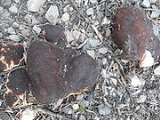
Rhizina undulata
Encyclopedia
Rhizina undulata, commonly known as the pine firefungus, is a species of fungi in the genus Rhizina, family Rhizinaceae. The fruiting bodies are dark purple brown with a bright yellow margin, crust-like and attached to the growing surface by numerous yellow rhizoid
s. R. undulata has a cosmopolitan distribution
, and commonly occurs on clearings or burned areas throughout central and northern Europe and North America. It is parasitic on conifer seedlings, and has caused considerable damage to tree plantation
s worldwide.
is dark purple brown to blackish, while the margin is pale yellow (like the underside), and wavy and irregular.
s are fusoid, apiculate, minutely verricose at maturity, with one or two oil drops, and have dimensions of 30–40 × 8–11 µm
. The asci are roughly cylindrical, and 250–280 × 14–18 µm. Like most other Pezizales, the asci open at maturity by means of an apical, lid-like flap of tissue termed an operculum. The paraphyses
are slightly club-shaped, tips encrusted with tubular setae, thin-walled, brown, aseptate and parallel-sided, tapering to a blunt point, and are 7–11 um wide.
of ascospores. The use of hot asphalt
(110-130°C) for paving new roads has also been observed to cause the same deleterious effect on neighboring conifers.
Rhizoid
Rhizoids are thread-like growths from the base or bottom of a plant, found mainly in lower groups such as algae, fungi, bryophytes and pteridophytes, that function like roots of higher plants ....
s. R. undulata has a cosmopolitan distribution
Cosmopolitan distribution
In biogeography, a taxon is said to have a cosmopolitan distribution if its range extends across all or most of the world in appropriate habitats. For instance, the killer whale has a cosmopolitan distribution, extending over most of the world's oceans. Other examples include humans, the lichen...
, and commonly occurs on clearings or burned areas throughout central and northern Europe and North America. It is parasitic on conifer seedlings, and has caused considerable damage to tree plantation
Plantation
A plantation is a long artificially established forest, farm or estate, where crops are grown for sale, often in distant markets rather than for local on-site consumption...
s worldwide.
Description
Fruiting bodies, which may be up to 6 centimetres (2.4 in) wide, are flat, with irregular lobes, and are attached to the growing surface on the entire lower side by numerous whitish to yellowish rhizoids. The hymeniumHymenium
The hymenium is the tissue layer on the hymenophore of a fungal fruiting body where the cells develop into basidia or asci, which produce spores. In some species all of the cells of the hymenium develop into basidia or asci, while in others some cells develop into sterile cells called cystidia or...
is dark purple brown to blackish, while the margin is pale yellow (like the underside), and wavy and irregular.
Microscopic characteristics
The sporeSpore
In biology, a spore is a reproductive structure that is adapted for dispersal and surviving for extended periods of time in unfavorable conditions. Spores form part of the life cycles of many bacteria, plants, algae, fungi and some protozoa. According to scientist Dr...
s are fusoid, apiculate, minutely verricose at maturity, with one or two oil drops, and have dimensions of 30–40 × 8–11 µm
Micrometre
A micrometer , is by definition 1×10-6 of a meter .In plain English, it means one-millionth of a meter . Its unit symbol in the International System of Units is μm...
. The asci are roughly cylindrical, and 250–280 × 14–18 µm. Like most other Pezizales, the asci open at maturity by means of an apical, lid-like flap of tissue termed an operculum. The paraphyses
Paraphyses
Paraphyses are part of the fertile spore-bearing layer in certain fungi. More specifically, paraphyses are sterile filamentous hyphal end cells composing part of the hymenium of Ascomycota and Basidiomycota interspersed among either the asci or basidia respectively, and not sufficiently...
are slightly club-shaped, tips encrusted with tubular setae, thin-walled, brown, aseptate and parallel-sided, tapering to a blunt point, and are 7–11 um wide.
Habitat and distribution
This is a widespread fungus that grows on burned soil or conifer debris. Although it is regarded as a saprobic species, it can also attack conifers of varying age parasitically. Rhizina undulata attack in recently established conifer plantations in areas where slash burning after clear felling has been performed is a well-known phenomenon. Because the optimum temperature for spore germination is high (35-45°C), the spores may lie dormant in soil for two years. As a result of these fires, the underlying soil is heated so that suitable conditions are created for the germinationGermination
Germination is the process in which a plant or fungus emerges from a seed or spore, respectively, and begins growth. The most common example of germination is the sprouting of a seedling from a seed of an angiosperm or gymnosperm. However the growth of a sporeling from a spore, for example the...
of ascospores. The use of hot asphalt
Asphalt
Asphalt or , also known as bitumen, is a sticky, black and highly viscous liquid or semi-solid that is present in most crude petroleums and in some natural deposits, it is a substance classed as a pitch...
(110-130°C) for paving new roads has also been observed to cause the same deleterious effect on neighboring conifers.

